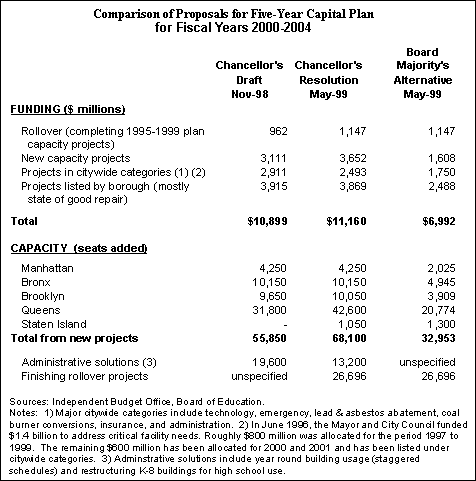
The Board of Education has rejected the Chancellor's resolution to approve an $11.2 billion capital plan for 2000 to 2004. As reported in the April 12th edition of Inside the Budget, serious questions had arisen regarding how much of the funding was secure and the allocation of new seats for Queens. The Board defeated the $11.2 billion resolution by a vote of 4-3 at a May 6th special meeting.
Debate over the 2000-2004 capital plan began in November 1998, when the Chancellor released a $10.9 billion draft plan. Over the next six months, the Chancellor revised his proposal in response to public hearings and additional analysis by the Board's Division of School Facilities. Details of the Chancellor's revised $11.2 billion resolution were not released until May 5th, only one day before the scheduled vote.
Immediately after rejecting the May resolution, the Board approved a one-page outline of a $7.0 billion alternative, while instructing staff to devise an entirely new plan conforming to the outline by May 10th; a new vote is scheduled for May 12th. It will be difficult, however, for the Board's staff to develop a comprehensive project list addressing the needs of over 1,100 school within such a short timeframe. The Board is rushing to prepare a replacement plan because they were legally required to approve a plan by March 1, 1999; the Mayor has said that he would withhold capital funds if the Board delays further.
The four Board members who presented the $7.0 billion alternative support the Mayor's position that the five-year plan should be limited in scope to capital projects that can be financed with funds the administration considers secure. In contrast, the Chancellor views the capital plan as a comprehensive strategy combining city, state, and federal funds. His staff considers $8.2 billion of the proposed $11.2 billion to be low risk, with $3.0 billion uncertain. The Chancellor's plan, however, did not specify which projects would be deferred if any of the funding were to fall through.
The $7.0 billion alternative outline places less emphasis on new capacity citywide than the defeated $11.2 billion resolution. Staten Island would receive a greater number of seats under the alternative, but the other four boroughs would receive far fewer. The attached table compares the November draft, May resolution, and Board majority alternatives. (While the upcoming five-year plan will expire June 30, 2004, many new capacity projects will likely take until 2005 and 2006 to complete.)
The November draft included 55,850 seats through construction and leasing and 19,600 seats through administrative solutions (using some buildings year round and restructuring some elementary/middle school buildings for high school use). The defeated $11.2 billion resolution called for building and leasing 68,100 seats and adding 13,200 seats through administrative solutions. The biggest change in the May resolution was to shift funds from citywide categories, such as technology and emergency repairs, to new construction for Queens. In contrast, the $7.0 billion alternative would build and lease just 32,953 seats with an unspecified number added through administrative solutions. Both the $11.2 billion and $7.0 billion proposals include $1.1 billion to finish 26,696 seats from projects initiated under the 1995-1999 capital plan.
